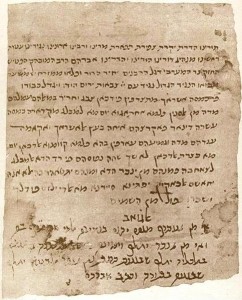Sukenik and the Dead Sea Scrolls, Part III Qumran Genizah
Continuing to see the cave as a genizah, he repented his view that the cave had been entered already in antiquity. In this way he explained some sherds that appeared to be dated later than the period of the scrolls.
Regarding this “genizah,” he had concluded that the scrolls had been placed there, as unfit books (ספרים פסולים), as in the case of the Cairo Genizah. He based his view on the terrible conditions of the Hodayot scroll, with its disconnected sheets. One scroll was only broken fragments and he assumed that this was the condition in which the scrolls were brought to the cave in antiquity.
He noted that other scholars disagreed with this conclusion, seeing the texts as hidden in a time of religious or political persecution. Kohle had suggested that these scrolls were put into genizah after the fixing of the biblical text, as they were no longer to be used.
But Sukenik stuck to his view of the “genizah,” because of the physical condition of the texts, especially the two Isaiah scrolls. But the proto-Masoretic Text nature of Isaiah B disproved for Sukenik the theory of Kohle. He saw the cave taken in placing the material in the cave, the clothes and the jars, as in line with Rabbinic laws about the handling of no longer usable holy books, including the requirement that they be placed in a dry vessel.
He also alluded to the possibility that the scrolls belonged to the same group that had authored the Zadokite Fragments (Damascus Document). This would explain why deteriorated scrolls were hidden all at once. He suggested that it occurred as the sectarians were on the way into exile in Damascus, and so they placed in genizah all the manuscripts that were not in good enough condition to warrant taking them along.


Dear Sir
Is it possible that Onias III had murdered along the way to Damascus?
from
John Stuart
Attention
Stephen Goranson
Can I point at the 3rd Paragraph these scrolls were hiidden during the King Antiochus IV persecutions of the Jews in 175 BCE after Onias III death.
from
John Stuart